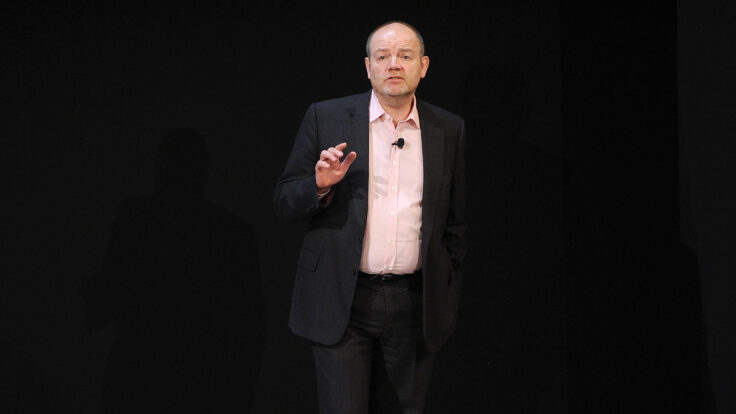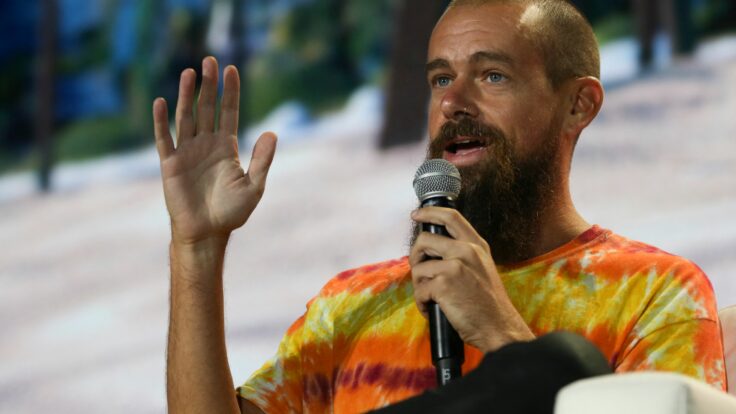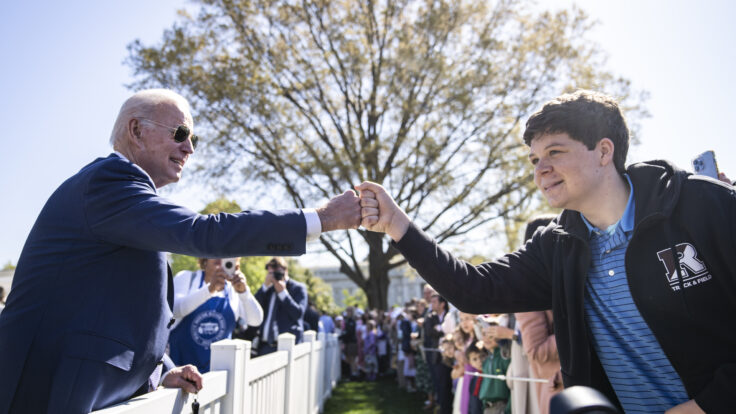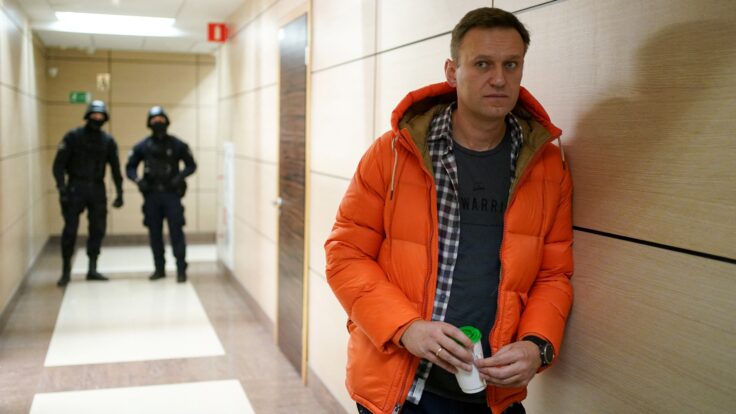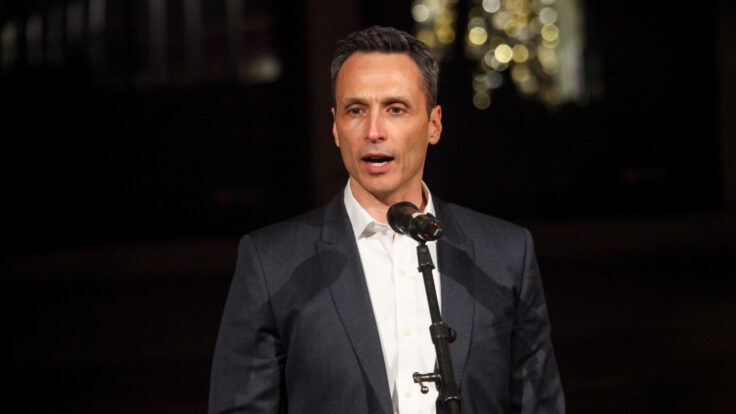 |
|
Welcome back to The Best & The Brightest. I’m Peter Hamby.
Tonight, my conversation with Sean Fine and Andrea Nix Fine, the award-winning filmmakers behind the new documentary The Sixth, which chronicles the U.S. Capitol riot of January 6 with shocking never-before-seen footage and an immersive view of the violence that sets the film apart from the media coverage—and political conversation—about that harrowing day.
But first, here’s Abby Livingston’s report from Capitol Hill…
|
| Dynasty Stress Tests & Arizona Anxiety |
|
With most of the year’s heavy legislative lifting in the rearview, Capitol Hill is now firmly in election season, with the chatter around town turning away from food fights on the House floor and toward the latest ad buys in key battleground races. Here are the latest murmurs…
- Ballad of the down-ballot Democrats: In recent days, Inside Elections shifted the Arizona Senate race—which is likely to pit Republican Kari Lake against Democrat Ruben Gallego—from Toss-up to Tilts Democratic. This underscores the strangeness of this election cycle, in which Biden’s poll numbers in places like Arizona send panic shooting through the Democratic Party, while down-ballot Democrats appear to have significant structural advantages. To wit: The rating change came just days before the Times and Siena College released a poll showing Trump with a larger-than-the-margin-of-error advantage over Biden in Arizona.
- Dynasty stress tests: The Senate primary in Maryland tomorrow could be a case study on the limits of campaign spending: Democrat David Trone—who has spent more than $54 million on his campaign, making him the top self-funder this cycle—is running against establishment favorite Angela Alsobrooks, who received a late boost from Emily’s List. Should Alsobrooks pull this out, the race will serve as a reminder that money can get a candidate into the hunt, but can’t always deliver a win. The winner will face former governor Larry Hogan in the general.
Meanwhile, in West Virginia’s Senate G.O.P. primary, Gov. Jim Justice is expected to defeat Freedom Caucus member Alex Mooney in a race to replace retiring Democrat Joe Manchin. But the real intrigue is how Moore Capito, son of senator and state power broker Shelley Moore Capito, will fare in his gubernatorial primary. Riley Moore, the senator’s nephew, is running for his aunt’s old 2nd District seat as well. The Moore family has been active in West Virginia politics for more than 70 years, dating back to the late family patriarch, Arch Moore, who was at the vanguard of turning a yellow dog Democratic state into a Republican stronghold.
- Menendez ripple effects: In other dynastic news, Democrat Bob Menendez’s federal corruption trial kicked off Monday in New York City, and it could not have come at a worse time for his son, first-termer Rob Menendez, who is fighting off a fierce challenge from Hoboken mayor Ravi Bhalla to retain his seat representing northern New Jersey’s 8th District. Bhalla has outraised Menendez cycle-to-date, and Menendez has a real shot at being the first Democratic incumbent to lose a primary this cycle when he faces voters on June 4.
Despite the charges against his father, much of the Democratic power base is rallying to Rob Menendez’s aid—including the Congressional Hispanic Caucus’ campaign arm, which dumped $500,000 into the race, and Senator Cory Booker, who has endorsed him.
|
| And now, my partner Eriq Gardner takes a quick look at the TikTok saga… |
| Gaming the TikTok Legal Strategy |
|
TikTok has gone on the legal offensive, challenging the freshly minted law that would ban the app in the U.S. if its Chinese parent company, ByteDance, doesn’t divest the entity. “For the first time in history, Congress has enacted a law that subjects a single, named speech platform to a permanent, nationwide ban,” reads the filing. The move wasn’t exactly shocking, and in the week since TikTok’s lawyers at Covington & Burling filed papers calling the law “unprecedented” and “obviously unconstitutional,” the punditry hasn’t been in short supply. Of course, I have thoughts on a case that’s heading toward becoming a memorable First Amendment showdown.
- Shortcuts have already weakened the law: I don’t subscribe to the notion that a TikTok ban is automatically a First Amendment faux pas, given that national security imperatives can sometimes elbow aside free speech. However, the American government’s failure to articulate precisely what TikTok or its Chinese owners are doing wrong undermines the defense. This lack of a robust rationale, ideally delivered with a broad data security review that extends beyond TikTok, could hobble the Department of Justice’s footing. My bet? TikTok will win the early rounds in court. Now about that judicial review…
- Things are about to get a tad funky: See, thanks to language baked into the law itself, TikTok starts out at the U.S. Court of Appeals for the D.C. Circuit, a venue not accustomed to rolling up its sleeves for fact-finding missions. That’s typically the terrain of district courts or executive branch agencies. Will the panel of appellate justices devise some novel protocol to address national security concerns? Will they do so openly? And if TikTok asks the D.C. Circuit to halt the law on a preliminary basis, would they try a cursory scan of the statute’s language to see if it squares with the U.S. Constitution without delving into the nitty-gritty of the national security arguments? I wouldn’t be surprised if one of the sides made a beeline for the Supreme Court at the earliest opportunity, but…
- The Supreme Court is an enigma: When it comes to issues that don’t fit into neat ideological pigeonholes, predicting the whims of the nation’s highest court is like deciphering prehistoric cave paintings. A clue may come from the court’s pending case concerning the Republican-backed laws in Texas and Florida that seek to limit the ability of social media companies to restrict content. If the justices rule that the First Amendment doesn’t tolerate interfering with the decisions of private speech platforms (even if the net result means the ongoing muzzling of Clarence Thomas’ favorite MAGA shitposters), it could be a welcome sign for TikTok. Then again, expect the high court to at least nod to compelling state interests. While I’m leaning toward TikTok having an edge at the D.C. Circuit, the Supreme Court is anyone’s guess.
- The Biden-Trump unknowns: There’s always a chance that Biden and Beijing hash out an accord to untangle this mess, although if the Chinese ever do warm up to the idea of a divestiture, ByteDance would be shrewd to broker those talks post-D.C. Circuit, but pre-Supreme Court denouement, when they can potentially negotiate with a stronger hand. Then there’s the looming specter of a Donald Trump comeback, now that he has shifted from TikTok foe to supporter, for reasons my partner Tara Palmeri elucidated. The prospect of his administration pumping the brakes on defending the law has to be factored in when trying to predict how the case resolves.
|
| Overall, I rate TikTok’s chances of survival as high. —Eriq Gardner |
 |
| Pleading the 6th |
| A bracing conversation with the filmmakers behind ‘The Sixth,’ the gritty new A24 documentary about what media coverage of the Capitol riot got wrong, the radical act of remembering, and how close we came to the brink. |
|
|
|
| The storming of the U.S. Capitol was a singular moment in the history of the United States—and yet, somehow, the day feels more and more memory-holed. In a new poll out today, The New York Times and Siena College found that only 5 percent of Americans named January 6, 2021, as the thing they remember most from Donald Trump’s presidency. Sure, there’s a lot to remember, but a bloodthirsty attack on the seat of American democracy doesn’t feel like it should only be a footnote. Maybe it’s the politics of it all, maybe it’s our feeble attention spans, or maybe it’s just that the ghastly violence on January 6 doesn’t fit into the tidy narratives we tell ourselves about the character of this country. Are we just choosing to forget?
Filmmakers Sean Fine and Andrea Nix Fine want to make sure that’s not the case. Their harrowing and (extremely) intense documentary, The Sixth, produced by A24 and Change Content, tells the story of January 6 through six people who lived through the violence, just by showing up for work that day: D.C. Metro police officers Daniel Hodges and Christina Laury, former D.C. police chief Robert Contee III, freelance photographer Mel Cole, former congressional staffer Erica Loewe, and Maryland Rep. Jamie Raskin.
The filmmakers and their team were there that day, too, working on what they thought would be a film about the peaceful transition of power. Instead, they ended up capturing eye-level footage of the attack, much of it never seen before the release of their film earlier this month. Blood, screams, weapons, death, fear—it’s all there, a visceral and chronological journey through the day, synced to the points of view of the narrators and their various confrontations with the angry MAGA hordes. I had to pause the movie three times just to take a deep breath. It’s far more moving and compelling than anything the House Select Committee investigating January 6 revealed in its 2022 public hearings, as important as they were.
The Sixth is not for the faint-hearted—you can watch the trailer here—but the filmmakers say that’s the point. It isn’t about Trump or Biden. “That day, it wasn’t about what side of the aisle you were on,” Sean Fine told me in a conversation I had with the filmmakers over the weekend. “People were running for their lives.” It’s a horror movie in some ways, hopeful in others.
The release of the film has been trailed by controversy. The Fines—Oscar-, Emmy-, and Peabody-winning filmmakers—have suggested that A24 and Amazon are limiting the scope of the release after making initial promises about its distribution. (Politico wrote about the dispute earlier this month.) I asked the Fines about A24, what media coverage of January 6 missed, whether the riot was actually an organized conspiracy, and more, in our lightly edited conversation below.
|
|
|
| Peter Hamby: We had the January 6th hearings. We had years of news saturation. There’s been a couple other documentaries about the Capitol riot. Aaron Sorkin told me and my colleague Matt Belloni recently that he’s making a movie about January 6th. Why does the world need more January 6 content?
Sean Fine: I don’t think we need more content. I think we need more depth. We need more emotional depth. We need to understand what people went through and what it was like. We need people to hear the voices in the crowd. We need people to see how violent it was. We need them to sit through it, and absorb it, and do that through the stories of the people who were there and experienced this. If we don’t do that, it becomes just a wash of noise.
Andrea Nix Fine: I can’t think of a more relevant time for people to remember what happened on January 6th. People who have seen our film are telling us, “I thought I knew, but I didn’t know what really happened that day, and I can’t stop thinking about this movie.” And the six people that we tell the story through are incredible. And it’s a very personal way that you remember, before people ascribe to the binary of which party or which side. These are human beings first, who went through one of the most traumatic days of their lives, which still affects them. And as Americans, it’s really important we come to terms with what this means for our democracy right now.
The January 6th Committee hired the former president of ABC News, James Goldston, to lend some narrative drama with the footage they used in the hearings. They did a pretty good job. The Sixth, though, is eye-level and immersive. You dive right into the action, rather than taking a larger look at the politics. Can you explain that creative choice?
Sean: For us it’s like, how do you feel like you’re there? How do you feel that you’re in the crowd? You feel the shouting behind you, you feel the words. You can almost feel the pepper spray—or the bear spray, in this situation. We wanted people to feel what it was like in the crowd, and what that crowd felt like. And on the opposite side, what it felt like if you were fearful of that crowd.
As a filmmaker, it was a crazy undertaking. We had this huge timeline of all the facts, but facts kept coming out. Then we had this big model of the U.S. Capitol that had schematics of where people were. For months, we were still trying to figure it all out. What happened? When? At what time? And then we had our characters, which were little pinpoints on the map. We physically had them on a table and we were moving them around to see where they were.
Andrea: We chose the chemistry of people because of their vantage points, because of who they are, their role that day, and also their geographic locations. So it was basically a telling of the story from six points, but also from very different types of what brings them into public service.
Sean: Our editors did an amazing job of capturing the sound of that day. That’s sometimes what we lose in the news, and what our film allows you to do is hear the sounds all around you. You hear people screaming, “Get their guns!” to the police. You hear somebody saying, “You’re going to die tonight,” behind a shield. You hear another protester saying, “We’re better than this.” Just these visceral, guttural screams and things going through this riot. And I think that that’s important. Everything is chronologically correct and to the clock, and when you hear a sound there, it happened at that time, it happened around that scene. So we feel really proud about that.
You guys touched on choosing not to focus on the political atmospherics of that time. We see Donald Trump briefly, and Raskin talks about Trump a little bit. But you don’t really talk about how we got to that point.
Sean: For us, it’s a nonpartisan film. We look at it as an American film. And so yes, Trump is in there. Yes, he’s part of that day, obviously. President Biden is in our film; he’s part of that day. But that day wasn’t about what side of the aisle you were on. People were running for their lives. Everybody was fearful that day. Our hope is that it ends up making people ask more questions than it does picking a side.
There’s a danger that if you make a film completely going after Trump, it doesn’t address all the questions. Andrea says it well, that it’s like a huge family argument—and if you don’t deal with that argument, it’s going to happen again. It’s going to be worse next time.
Andrea: The other part is that, obviously, Trump steals all the air in the room. We wanted to show what the effect was on the people who just showed up for work that day. Because that’s the piece I still don’t think people have any idea about. I didn’t, despite watching coverage on the news. Until we started really looking at the massive scale of this, the number of people, and how close this whole thing came to utter disaster, enormous loss of life, unseating the election, the entire thing, I mean, it was so close.
In the West Tunnel—which is where Officer Hodges and Christina Laury were—the whole film coalesces at that moment. When we started looking at the footage, it was vicious and packed, and the violence that was coming through that and the weaponry—there’s sledgehammers, there’s bats, there’s fire extinguishers, there’s bricks, there’s metal spear poles, there’s men who have tactical gear on and who obviously have formation training that are moving in. Had the group we were looking at gotten through, I think it would’ve been an incredibly violent outcome.
|
| Organized Conspiracy Theories |
|
| You guys spent months in the edit, sorting through raw footage. Were there moments when you had to take a break? Go for a walk? I’m curious about your emotional response from living with this violent footage for so long.
Sean: I think all of us who worked on it, especially the edit team, had moments where it just got to everybody. Everybody broke down at some point. Everybody was angry at some point. But for me at least, the hope in the characters, and what they share with us, rises above looking through the footage and all that stuff that was part of making it.
Andrea: Making this, there is shame in it, shame of looking at your country like that. And then the sorrow that you feel that it’s come to that. But then there’s the decency you feel in the people that we follow. Thank God they came through that day. There’s a sense of decency and a code, a principle that we haven’t focused on enough and been able to embrace in law enforcement and government. These people are the real deal, and they’re so normal and they’re such superheroes at the same time.
At the end of your film, Raskin says, “This was an organized attack on the government.” There are tactical weapons in the crowd, coordinated movements by some parts of the crowd. But the day I watched it unfold, it felt like the dog that caught the car. These people get in the Capitol and they’re like, “Oh, hey, we’re here.” But it didn’t feel like an organized conspiracy. I’m wondering, in watching the footage, how much of all that rioting felt organized to you?
Sean: When you see people with tactical vests, helmets, bear spray, military-style apparel, you have to say to yourself, If I saw one or two people with that stuff, that would be interesting. But when you see multiple people with things that look like battle gear, you have to ask yourself, What’s their objective? Why are they here? I do think there was a part of the crowd that was there to get into the Capitol, and I think there was a part of the crowd that knew how to whip the rest of the crowd into a frenzy.
A riot is a living, breathing organism of its own. I’m not talking about the shaman idiot inside with the horns and all that stuff. I’m talking about the people in our film on the outside who are carrying a sledgehammer or pulling a police officer down the capitol steps and beating him with a flag. I’m talking about people who are telling police officers, “We know your name. We know where you live.” Shouting, “Take their guns!” Horrible, horrible things. “You’re going to die tonight!” This is the emotion of an organism that’s been whipped up.
I mean, there were pipe bombs. Nobody talks about that anymore. But in the beginning of the day, there were two pipe bombs. That’s not a random occurrence. There were munitions found in hotel rooms out in Virginia. To be honest, we tried to talk to a few insurrectionists for this film, to see if we could put them in there, before we came to the idea that we couldn’t—some for legal reasons. But some of them told us, When this happens again, we’re going to grab our weapons and we’re ready. And that’s very scary.
I have to ask you the A24 question. What’s the deal there? You have to navigate to a certain section of the website just to find promotion for the film. It’s not being promoted on their social media accounts. You were told it would stream on Amazon Prime on the day of its release, but I just had to pay $19.99 to rent it on Amazon instead. And the studio clearly isn’t putting promotional muscle behind it like they did recently with Civil War, which also happens to be about the possible end of American democracy.
Andrea: We care first and foremost about getting the film out. It is true to say that the difference with the Amazon thing is that when it’s widely distributed, it’s 200 million viewers as a potential viewership, they get that if it’s part of their Prime membership. But if they postpone that, it means at first you have to buy it for $20 or rent it. That changes the dynamic of access. It changes the economics of access. And we feel this is an American story that needs to be seen by as many people as possible.
But is that an Amazon decision or an A24 decision on how it gets distributed?
Andrea: A24 is the studio, but they paid for this film. They fully funded this film and they stayed with it over a really long time. Political subject matter is tough in entertainment right now, it just is. And they stayed with that. And we really appreciate that commitment.
Sean: Our job is to make a great film. Our job is to also protect and keep sacred our characters that are in our film. And part of that is telling them when their story is going to be shown, how their story is going to be shown. All I can say is, for us, to be told one thing, then it changes and something else happens, that’s difficult for the people that are in our film. That’s really hard to share your story and be told it’s going to be viewed one way. You’re excited about that and you’re telling everybody. And then you hear, Oh no, you have to buy it on video-on-demand two weeks before it was supposed to come out. And, of course, they looked to us for answers. I mean, the answers lie between Amazon and A24 and their negotiations. I don’t really have any answers for it.
|
|
|
|
| FOUR STORIES WE’RE TALKING ABOUT |
 |
| CNN Fantasies |
| Could Jeff Zucker really return to CNN? |
| DYLAN BYERS |
|
 |
| Vulcan Zaz |
| On David Zaslav’s potential spoils from the Paramount mess. |
| WILLIAM D. COHAN |
|
 |
|
 |
|
|
|

|
 |
|
|
|
Need help? Review our FAQs
page or contact
us for assistance. For brand partnerships, email ads@puck.news.
|
|
You received this email because you signed up to receive emails from Puck, or as part of your Puck account associated with . To stop receiving this newsletter and/or manage all your email preferences, click here.
|
|
Puck is published by Heat Media LLC. 227 W 17th St New York, NY 10011.
|
|
|
|








